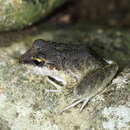ar
الأسماء في صفحات التنقل


On a collecting trip to the Peruvian Andes in February, 1975, a team of three herpetologists (W.E. Duellman, L. Trueb, J.E. Simmons) and W.E. Duellman’s daughter (Dana K. Duellman), collected four frog species new to science.One of these was Pristimantis danae (family Craugastoridae), the Cuzco robber frog, which Duellman named for his daughter when he described these new species in 1978, “in recognition of her youthful enthusiasm for collecting frogs in the Andes.
Found from Cuzco, Peru though to central Bolivia, this terrestrial, nocturnal frog is common in primary and secondary tropical moist forests within a wide altitudinal range (200-1800 m asl).It perches on vegetation close to the ground.Froglets hatch directly from eggs laid on the ground, bypassing the tadpole stage.
Though common and wide-ranging, this species is locally susceptible to deforestation, as it is not adaptable to modified habitat. It is present in several protected areas, such as Madidi National Park in Bolivia and Manu and Bahuaja-Sonene National Parks, in Peru. Of higher impact to Pristimantis danae, Catenazzi et al. (2011, 2014) found it susceptible to the pathogenetic fungus Batrachochytrium dendrobatidis (Bd), which has been devastating for some amphibian species world wide.Between 5-21% of immature and 11-21% of adult frogs they examined from Manu National Park were infected with Bd spores during the rainy seasons of 2008-9. These authors believe there is serious concern for extinction of this and other Andean frog species as this epidemic spreads along the Andean mountain range, leading to a significant decline or collapse of species richness in montane forests.
(Duellman 1978; Rodriguez et al. 2004; Catenazzi et al. 2011; Catenazzi et al. 2014)
Pristimantis danae is a species of frog in the family Strabomantidae, sometimes known as Cuzco robber frog. It is found in the Andes between southern Peru and north-western Bolivia.[3] It is named after the daughter of the author, Dana K. Duellman, who helped in collecting the frogs.[2][4] Pristimantis reichlei, described in 2009, was previously confused with Pristimantis danae.[3]
Male Pristimantis danae grow to a snout–vent length of 27–34 mm (1.1–1.3 in) and females to 38–46 mm (1.5–1.8 in). Body is moderately robust, with head slightly longer than it is wide. The snout is rounded in dorsal view and in profile. The tympanum is prominent. Forearms are slender and hind limbs are limbs long and slender. The fingers and the toes have lateral fringes and bear wide discs; the toes have also basal webbing. Skin on dorsum is finely shagreened; its color is yellowish tan to dark reddish brown with dark brown chevrons. The ventral side is pale yellow, and the hidden surfaces of the thighs are dark brown with pale yellow spots.[2]
Pristimantis danae occurs in primary and secondary tropical moist forests[1] at elevations of 500–1,700 m (1,600–5,600 ft) above sea level.[3] This common frog may be found perched on low vegetation in cloud forest at night. It does not occur in modified habitats.[1]
Pristimantis danae is a species of frog in the family Strabomantidae, sometimes known as Cuzco robber frog. It is found in the Andes between southern Peru and north-western Bolivia. It is named after the daughter of the author, Dana K. Duellman, who helped in collecting the frogs. Pristimantis reichlei, described in 2009, was previously confused with Pristimantis danae.
Pristimantis danae es una especie de anfibio anuro de la familia Craugastoridae.[2]
Se distribuyen por el sur de Perú y el norte de Bolivia, entre 500 y 1700 m de altitud, en los Andes, en el bosque húmedo tropical primario y secundario.
Está amenazada por la pérdida de su hábitat natural.
Pristimantis danae es una especie de anfibio anuro de la familia Craugastoridae.
Se distribuyen por el sur de Perú y el norte de Bolivia, entre 500 y 1700 m de altitud, en los Andes, en el bosque húmedo tropical primario y secundario.
Está amenazada por la pérdida de su hábitat natural.
Pristimantis danae Pristimantis generoko animalia da. Anfibioen barruko Craugastoridae familian sailkatuta dago, Anura ordenan.
Pristimantis danae Pristimantis generoko animalia da. Anfibioen barruko Craugastoridae familian sailkatuta dago, Anura ordenan.
Pristimantis danae est une espèce d'amphibiens de la famille des Craugastoridae[1].
Cette espèce se rencontre entre 500 et 1 700 m d'altitude[1],[2] :
Les mâles mesurent de 27,3 à 33,8 mm et les femelles de 37,5 à 45,8 mm[3].
Cette espèce est nommée en référence à Dana K. Duellman, la fille de William Edward Duellman[3].
Pristimantis danae est une espèce d'amphibiens de la famille des Craugastoridae.
Pristimantis danae é uma espécie de anfíbio da família Craugastoridae.
Pode ser encontrada nos seguintes países: Bolívia e Peru.
Os seus habitats naturais são: florestas subtropicais ou tropicais húmidas de baixa altitude e regiões subtropicais ou tropicais húmidas de alta altitude.
Pristimantis danae é uma espécie de anfíbio da família Craugastoridae.
Pode ser encontrada nos seguintes países: Bolívia e Peru.
Os seus habitats naturais são: florestas subtropicais ou tropicais húmidas de baixa altitude e regiões subtropicais ou tropicais húmidas de alta altitude.
Pristimantis danae là một loài động vật lưỡng cư trong họ Strabomantidae, thuộc bộ Anura. Loài này được Duellman mô tả khoa học đầu tiên năm 1978.[3]
Pristimantis danae là một loài động vật lưỡng cư trong họ Strabomantidae, thuộc bộ Anura. Loài này được Duellman mô tả khoa học đầu tiên năm 1978.